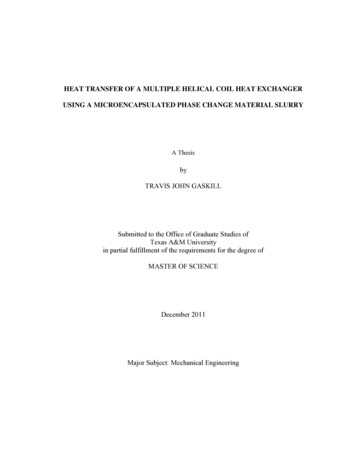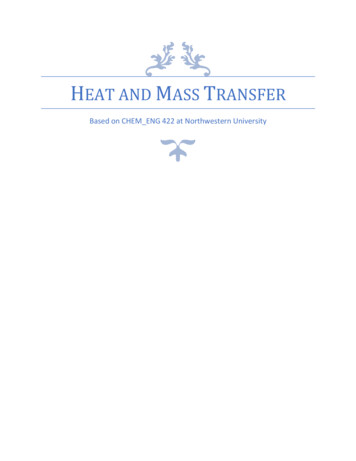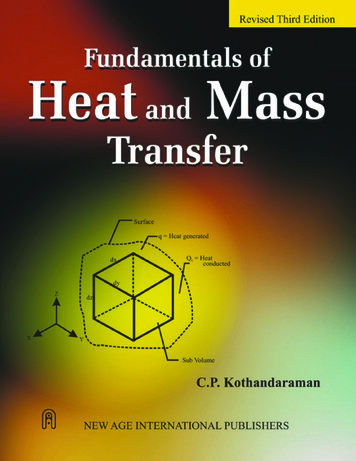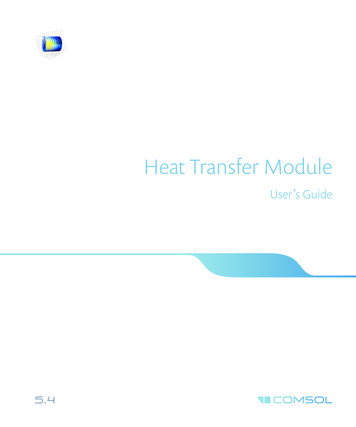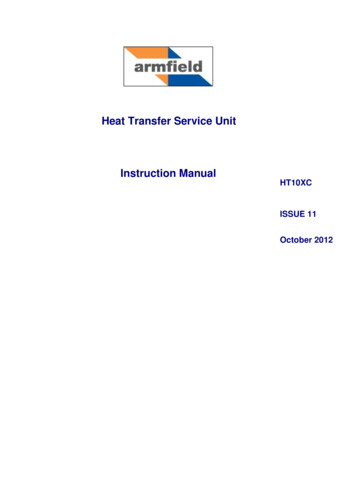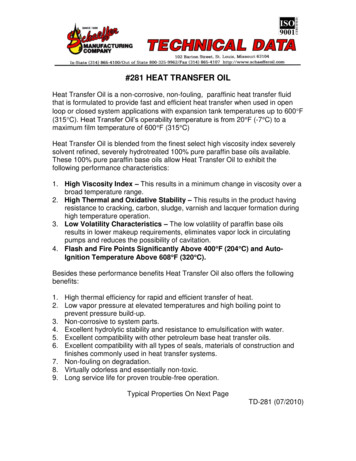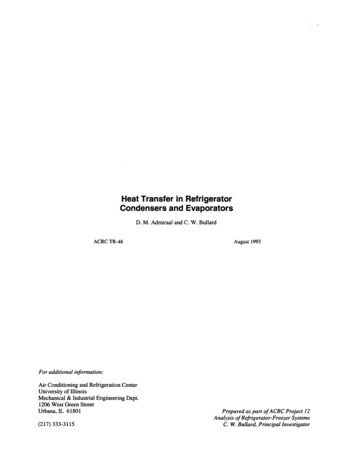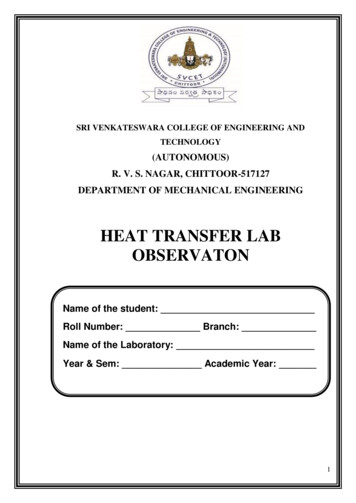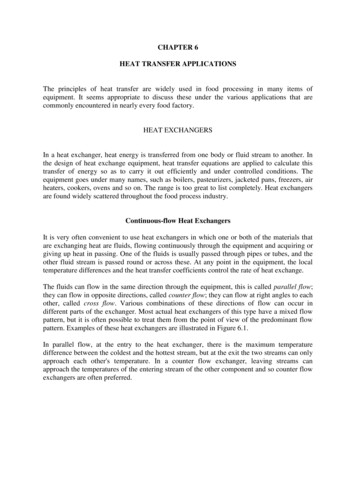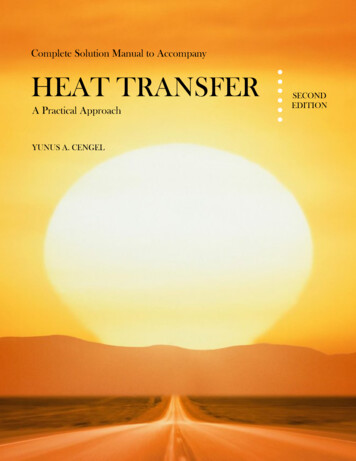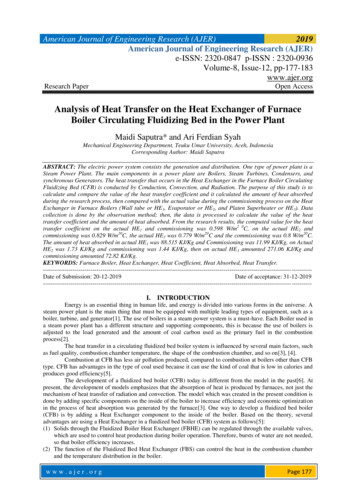
Transcription
American Journal of Engineering Research (AJER)2019American Journal of Engineering Research (AJER)e-ISSN: 2320-0847 p-ISSN : 2320-0936Volume-8, Issue-12, pp-177-183www.ajer.orgResearch PaperOpen AccessAnalysis of Heat Transfer on the Heat Exchanger of FurnaceBoiler Circulating Fluidizing Bed in the Power PlantMaidi Saputra* and Ari Ferdian SyahMechanical Engineering Department, Teuku Umar University, Aceh, IndonesiaCorresponding Author: Maidi SaputraABSTRACT: The electric power system consists the generation and distribution. One type of power plant is aSteam Power Plant. The main components in a power plant are Boilers, Steam Turbines, Condensers, andsynchronous Generators. The heat transfer that occurs in the Heat Exchanger in the Furnace Boiler CirculatingFluidizing Bed (CFB) is conducted by Conduction, Convection, and Radiation. The purpose of this study is tocalculate and compare the value of the heat transfer coefficient and it calculated the amount of heat absorbedduring the research process, then compared with the actual value during the commissioning process on the HeatExchanger in Furnace Boilers (Wall tube or HE 1, Evaporator or HE2, and Platen Superheater or HE3). Datacollection is done by the observation method; then, the data is processed to calculate the value of the heattransfer coefficient and the amount of heat absorbed. From the research results, the computed value for the heattransfer coefficient on the actual HE1 and commissioning was 0.598 W/m2 0C, on the actual HE2 andcommissioning was 0.829 W/m20C, the actual HE3 was 0.779 W/m20C and the commissioning was 0.8 W/m20C.The amount of heat absorbed in actual HE1 was 88.515 KJ/Kg and Commissioning was 11.99 KJ/Kg, on ActualHE2 was 1.73 KJ/Kg and commissioning was 1.44 KJ/Kg, then on actual HE 3 amounted 271.06 KJ/Kg andcommissioning amounted 72.82 KJ/Kg.KEYWORDS: Furnace Boiler, Heat Exchanger, Heat Coefficient, Heat Absorbed, Heat ---------------------------------- ---------Date of Submission: 20-12-2019Date of acceptance: ----------------------------------- ----------I. INTRODUCTIONEnergy is an essential thing in human life, and energy is divided into various forms in the universe. Asteam power plant is the main thing that must be equipped with multiple leading types of equipment, such as aboiler, turbine, and generator[1]. The use of boilers in a steam power system is a must-have. Each Boiler used ina steam power plant has a different structure and supporting components, this is because the use of boilers isadjusted to the load generated and the amount of coal carbon used as the primary fuel in the combustionprocess[2].The heat transfer in a circulating fluidized bed boiler system is influenced by several main factors, suchas fuel quality, combustion chamber temperature, the shape of the combustion chamber, and so on[3], [4].Combustion at CFB has less air pollution produced, compared to combustion at boilers other than CFBtype. CFB has advantages in the type of coal used because it can use the kind of coal that is low in calories andproduces good efficiency[5].The development of a fluidized bed boiler (CFB) today is different from the model in the past[6]. Atpresent, the development of models emphasizes that the absorption of heat is produced by furnaces, not just themechanism of heat transfer of radiation and convection. The model which was created in the present condition isdone by adding specific components on the inside of the boiler to increase efficiency and economic optimizationin the process of heat absorption was generated by the furnace[3]. One way to develop a fluidized bed boiler(CFB) is by adding a Heat Exchanger component to the inside of the boiler. Based on the theory, severaladvantages are using a Heat Exchanger in a fluidized bed boiler (CFB) system as follows[5]:(1) Solids through the Fluidized Boiler Heat Exchanger (FBHE) can be regulated through the available valves,which are used to control heat production during boiler operation. Therefore, bursts of water are not needed,so that boiler efficiency increases.(2) The function of the Fluidized Bed Heat Exchanger (FBS) can control the heat in the combustion chamberand the temperature distribution in the boiler.www.ajer.orgwww.ajer.orgPage 177
American Journal of Engineering Research (AJER)2019(3) Fluidized Bed Heat Exchanger (FBHE) can flexibly regulate the bed temperature inside of boiler by settingthe combustion in the combustion chamber.(4) Fluidized Bed Heat Exchanger (FBHE) regulates the flexibility of the temperature bed in the boiler, forvarying boiler load capacities.The technology and capacity of fluidized bed boilers (cfb) which was applied today is an increase (fig.1). Currently, under the development and construction of more than 500 units of fluidized bed boilers (cfb) isworldwide. The most significant capacity building is 500 MWe currently underway in Gujarat, India, and otherlocations with capacities are reaching 600 MWe[7].Fig. 1. The growth of the gross electrical output of CFB boilers[7]I.1 Coal FuelCombustion in a fluidized bed boiler (cfb) gives a good combustion value, even though the value andquality of the fuel which was used are not good[8]. The quality of combustion results in the fluidized bed boileris also influenced by the design of a good furnace and it is equipped with a fluidized bed heat exchanger in theboiler unit (figure 2)[7].Fig. 2. Schematic of a CFB boiler furnace[7]www.ajer.orgwww.ajer.orgPage 178
American Journal of Engineering Research (AJER)2019I.2 Heat Transfer ProcessThe process of heat transfer in a fluidized bed boiler (cfb) occurs in the mode of heat transfer byconvection and radiation which takes place simultaneously, but the process of calculation and assessment can bedone separately[9].a.ConvectionConvection heat transfer in the fluidized bed boiler (cfb) occurs due to the volumetric heat capacity thatis much higher than the gas in the boiler, so the heat transfer that occurs will increase at higherconcentrations[9], [10].The volume fraction of particles in a fluidized bed boiler (cfb) is about three times the average of the crosssectional area. The volume fraction of a particle in a wall is proportional to the volume fraction in the boilercore; thereby affecting the heat transfer is through the particle.b. RadiationRadiation heat transfer in a fluidized bed boiler (cfb) occurs due to several factors, including the opticalwall layer and wall thickness[11]. Assuming that the cross-sectional area of the boiler equals the geometriccross-sectional area of the particles inside the boiler, the optical thickness can be calculated as[9], [11]:xτ 3ϕ/2dp dx0The heat generated in the fluidized bed boiler (cfb) varies for several positions in the boiler. Thetemperature around the center of the boiler is around 850 0C and the particle temperature close to the boiler wallis around 200 0C[12]. The chosen emissivity is around 0.8 which is the combined emissivity of particles andgases[9]. 1α r 1 εs 1 εw 1α Ts2 Tw2 Ts Twεs 1 1 εpc1 εg εpc εg εpc εgBecause the emissivity of particles is scattering, the relationship between particles gives the following results[9],[13], [14].εpc ε0.31pThe combustion gas emissivity in a large combustion condition gives a value of 0.25 which iscombustion emissivity in a fluidized bed boiler (cfb) of 0.6, in Eq (4). The cloud emissivity of the particlesbecomes 0.85, in Eq. (3), then a total suspension emissivity for the gas particles in the boiler is obtained 0.88.The limit of emissivity validity for radiant heat transfer is given by the following equation:αηr r αr,maxFig. 3. Radiation efficiency as a function of suspension densitywww.ajer.orgwww.ajer.orgPage 179
American Journal of Engineering Research (AJER)2019The problems that arise in the steam power plant produce a lack of reliability of the power plantsystem, and it has an impact on the durability of the leading equipment. Based on the description above, theauthors are interested in conducting research "Analysis of Heat Transfer on the Heat Exchanger of FurnaceBoiler Circulating Fluidizing Bed in the Power Plant".II. EXPERIMENTSII.1 Structure of Fluidized Bed Heat Exchanger (FBHE) and hot circulation loopFluidized Bed Heat Exchanger has a structure with a lower fluidization speed than other fluidized bedstructures (Fig. 3). Circulating solids enter the heat exchanger through the inlet valve, and then the heat in theparticles is transferred to the heat exchanger and exits again at a lower temperature[5].Fig. 4. Fluidized Bed Heat Exchanger StructureThe quantity of coal from the bunker to the combustion chamber is carried out through coal feeders,mill pulverizes, and coal pipes. Arrangement and recording of the amount of coal flow are done with a coalfeeder. The lignite was fired in the boiler, and the ultimate analysis is given in Table 1[5].Table 1: Ultimate analysis of fired coal of SulfurSar%AshAar%MoistureWar%VolatileVdaf%Heat 12,435II.2 Method and principles of the experimentsA result of the combustion process that occurs in the boiler causes containing heat in the fuel; it movesto water or steam through the Heat Exchanger. The heat absorption of the heat exchanger can be measured bythe increase in enthalpy that occurs in the boiler, and the coefficient of heat transfer from each surface in theboiler can be obtained by the Eq (6).QK H tQ is the heat absorbed in the heater, H is the total number of heaters, and Δt is the logarithmic temperaturedifference, see Eq (7).Tai Ts0 Ta0 Tsi t T i T 0ln a0 siT a T sWhere Tai and Ta0 are the solids temperatures at the inlet and outlet of each chamber, Tsi and Ts0 are thesteam temperatures at the inlet and outlet of each chamber.In the engineering design, the heat transfer coefficient is calculated by Eq (8), and the denominator includes11three parts, bed side thermal resistance , medium side thermal resistance β and thermal resistance of heatingδα1α2surface itself respectively.λwww.ajer.orgwww.ajer.orgPage 180
American Journal of Engineering Research (AJER)K 201911α1 1α2β δλWhere α1 is nominal heat transfer coefficient from the bed to total heating surface, W/(m2·0C); α2 isthe heat transfer coefficient of medium side, W/(m2·0C), and Sieder-Tate equation is adopted for its calculation(see Eq 9) [9]; β is a ratio between the external and internal areas of the heating surface; δ is the thickness of theheating surface tubes, m and λ is the metal thermal conductivity of the heating surface, W/(m2·0C).0.023 ωμ 0.14α2 0.20.66Re PrμwWhere Re is Reynolds number of the medium in the tube, Pr is Prandtl number, ω is the flow velocity,m/s, ρ is the medium density, kg/m3, c is the specific heat of the medium, kJ/(kg·0C), μ is the viscosity with theaverage temperature of the medium, kg/(m·s), and μω is the viscosity of the medium with metal temperature,kg/(m·s).The observations were made to collect all data related to the operation of the power plant. Based oncalculations of heat transfer, the data occur on the monitor of the controller room. Measuring instruments usedin this study were installed in the control room, and they were connected in the field.III. RESULTS AND DISCUSSIONIII.1 Research ResultsData from research results obtained an analysis of displacement calculations in furnace boiler:Table 4: Log sheet data parameter average valueLoadTin HE1Tout HE1Tin HE2Tout HE2Tin HE3Tout HE3P HE373.94 MW280.5267 0C293.7667 0C293.7667 0C297.0967 0C393.2533 0C452.3167 0C7.34 MPaTspace HE1Tspace HE1& HE2ToutspacePspaceQwaterQsteamQairP HE1& HE2884.4533 0C917.363333 0C867.8233 0C-213.23 Pa283.4133 ton/day273.23 ton/day297.6033 KNm/day8.076667 MPaIII.2 The value of heat transfer on the surface at FBHEConduction Heat TransferCombustion in boiler furnaces occurs through heat transfer by conduction, with the thermalconductivity value of the material at HE1 54 W/m0C, pipe area 1,168.8 m2, temperature difference 13.4 0C(286.5 0K), and boiler height 27.7 m, then obtained qk -29,973.6 W.Radiation Heat TransferRadiation heat transfer on the heat exchanger is obtained with the value of the Boltzmannconstant 5,669.10-8 W/m2.K4, cross-sectional area 1,164.8 m2, and the water temperature at HE 293.7 0C,then obtained qr 491,330 W.Determine Mean Temperature Difference (LMTD)Given the value of the inlet temperature HE 280.5 0C, the outlet temperature HE 293.7 0C, the inlettemperature of the combustion chamber 884.4 0C, and the combustion chamber outlet temperature 867.8 0C,with HE flow and combustion chamber in the same direction, then obtained value Tm 599.09 0C.Overall Heat Transfer CoefficientThe internal pipe forced convection value must be determined as well as the outer pipe forcedconvection. The value of nusselt number 3.6669, thermal conductivity 54 W/m 0C and inner diameter 0.054m, the overall heat transfer coefficient (U0) value is 0.598 W/m0C.Amount of Heat AbsorbedAfter knowing the overall heat transfer coefficient value, the amount of heat was absorbed by the fluid in HE is88.515 kJ/kg.www.ajer.orgwww.ajer.orgPage 181
American Journal of Engineering Research (AJER)2019Table 5: Comparison between actual data and commissioningspecifiedparametersconductionflow rateradiation fficientheat absorbedHE1 (wall tube)actualCommissioningHE2 (evaporator)actualCommissioningHE3 (platen superheater)actualCommissioning-29,973 W-10,672.3 W-1,924.56 W-1,749.71 W-27,426.47 W-13,931.49 W491,330 W555,846.57 W51,939.041W122,124.23 W262,117.77W256,826.7 W599.09 0C235.83 0C599.92 0C235.83 0C468.2 0C446.2 0C0.598 W/m20C88.515 kJ/kg0.598 W/m2 0C11.99 kJ/kg0.829 W/m20C1.73 kJ/kg0.829 W/m2 0C1.44 kJ/kg0.799 W/m20C271.06 kJ/kg0.8000 W/m2 0C72.82 kJ/kgIII.2 DiscussionBased on observations and data collections, the data is known that the Heat Exchanger material usedin Wall tube and Evaporator is carbon steel SA 210 A with a carbon percentage of 0.27%, a thermalconductivity value of 54 W/m 0C. Superheater platen uses carbon low alloy steel material with a carbonpresentation of 1% and a thermal conductivity value of 43 W/m0C.The conduction flow rate at HE1 -29,973.6 W, HE2 -1,925.56 W, and HE3 -27,426.47 W, theminus sign (-) in the calculation results shows that heat moves under high temperature (combustion chamber)leading to low temperature (working fluid). The high conduction flow rate in HE1 is due to the wide crosssection in HE1 that surrounds the boiler furnace while for HE 2 and 3 which have be a vast difference betweenthe two is due to the higher number of pipes in HE 3 and the different material used.The radiation rate that occurs at HE1 41,330 W, HE2 51,939 W, and HE3 262.117 W shows thatthe high radiation emission at HE3 is influenced by the temperature of the working fluid and it was producedand also was caused by the working fluid at HE3 which has turned into dry steam.The difference in average temperature which was measured by the LMTD method obtained data atHE1 599.09 0C, HE2 599.92 0C, and HE3 468.2 0C. This data shows the value of the heat transfer in the flowsystem, especially on heat exchangers.The overall heat transfer coefficient at each HE has been the same value, namely HE1 0.598 W/m20C, HE2 0.829 W/m2 0C, and HE3 0.799 W/m2 0C. The overall coefficient of heat transfer at HE3 is greaterthan HE 1 and 2, and due to the material which was used is different. The amount of the heat absorbed for eachHeat Exchanger is HE1 88,515 KJ/Kg, HE2 1.73 KJ/Kg, and HE3 271.06 KJ/Kg.From the results of the comparison actual data and commissioning, the data is shown that the value foreach commissioning is getting smaller and it was excepted in the overall heat coefficient. From the calculationdata, there is also no visible movement or slaking of the heat exchanger in the Furnace Boiler because thefluidizing air which contained in the furnace is sprayed in the direction of the combustion process.IV. CONCLUSIONSSome things can be concluded from the results of the calculation analysis, as follows:1. The heat transfer coefficient for each heat exchanger in the actual state includes HE1 0.598 W/m2 0C,HE2 0.829 W/m2 0C, and HE3 0.799 W/m2 0C, then at the commissioning state of 0.8 W/m2 0C.2. The amount of heat absorbed for each heat exchanger in the actual and commissioning state is HE1 88,515KJ/Kg for the actual measurement and 11.99 KJ/Kg for the commissioning, HE2 1.73 KJ/Kg for actualmeasurements and 1.44 KJ/Kg for the commissioning, and HE3 271.06 for actual measurements and 72.82KJ/Kg for commissioning.3. The difference in the amount of heat absorbed during the commissioning and actual process is due to thereducing heat that can be absorbed during the preheater and it causes an increase in heat absorption for eachheat exchanger in the Boiler Furnace.REFERENCES[1].“Power Plant Engineering - Google Buku.” [Online]. Available:https://books.google.co.id/books?hl id&lr &id J5bfBwAAQBAJ&oi fnd&pg PP7&dq electric steam power plants&ots ClQoutl7jN&sig 28HpGlhgnGthGown5zA7OXB0sn8&redir esc y#v onepage&q electric steam power plants&f false. [Accessed: 16-Oct2019].[2].J. G. Singer, Combustion, fossil power systems : a reference book on fuel burning and steam generation. Combustion Engineering,1981.[3].P. Basu and P. K. Nag, “Heat transfer to walls of a circulating fluidized-bed furnace,” Chem. Eng. Sci., vol. 51, no. 1, pp. 1–26,1996.[4].J. Krzywanski and W. Nowak, “Modeling of heat transfer coefficient in the furnace of CFB boilers by artificial neural networkapproach,” Int. J. Heat Mass Transf., vol. 55, no. 15–16, pp. 4246–4253, 2012.www.ajer.orgwww.ajer.orgPage 182
American Journal of Engineering Research .2019M. Zhang, H. Wu, Q. Lu, Y. Sun, and G. Song, “Heat transfer characteristics of fluidized bed heat exchanger in a 300MW CFBboiler,” Powder Technol., vol. 222, pp. 1–7, 2012.R. Sundaresan and A. K. Kolar, “Core heat transfer studies in a circulating fluidized bed,” Powder Technol., vol. 124, no. 1–2, pp.138–151, Apr. 2002.P. Basu, “Combustion of coal in circulating fluidized-bed boilers: A review,” Chem. Eng. Sci., vol. 54, no. 22, pp. 5547–5557,1999.H. Arastoopour, “Circulating fluidized bed boilers: Design and operations. By P. Basu and S. Fraser, 1423 pp.,” AIChE J., vol. 39,no. 4, pp. 727–727, Apr. 1993.C. Breitholtz, B. Leckner, and A. P. Baskakov, “Wall average heat transfer in CFB boilers,” Powder Technol., vol. 120, no. 1–2, pp.41–48, 2001.L. R. Glicksman, M. R. Hyre, and P. A. Farrell, “Dynamic similarity in fluidization,” Int. J. Multiph. Flow, vol. 20, pp. 331–386,Aug. 1994.A. P. Baskakov and B. Leckner, “Radiative heat transfer in circulating fluidized bed furnaces,” Powder Technol., vol. 90, no. 3, pp.213–218, Mar. 1997.C. E. Weinell, K. Dam-Johansen, and J. E. Johnsson, “Single-particle behaviour in circulating fluidized beds,” Powder Technol.,vol. 92, no. 3, pp. 241–252, Aug. 1997.Perdana, “済無 No Title No Title,” J. Chem. Inf. Model., vol. 53, no. 9, pp. 1689–1699, 2018.A. P. Baskakov and B. Leckner, “Radiative heat transfer in circulating fluidized bed furnaces,” Powder Technol., vol. 90, no. 3, pp.213–218, Mar. 1997.Maidi Saputra "Analysis of Heat Transfer on the Heat Exchanger of Furnace Boiler CirculatingFluidizing Bed in the Power Plant" American Journal of Engineering Research (AJER), vol. 8,no. 12, 2019, pp 177-183www.ajer.orgwww.ajer.orgPage 183
One way to develop a fluidized bed boiler (CFB) is by adding a Heat Exchanger component to the inside of the boiler. Based on the theory, several advantages are using a Heat Exchanger in a fluidized bed boiler (CFB) system as follows[5]: (1) Solids through the Fluidized Boiler Heat Exchanger (FBHE) can be regulated through the available valves,
